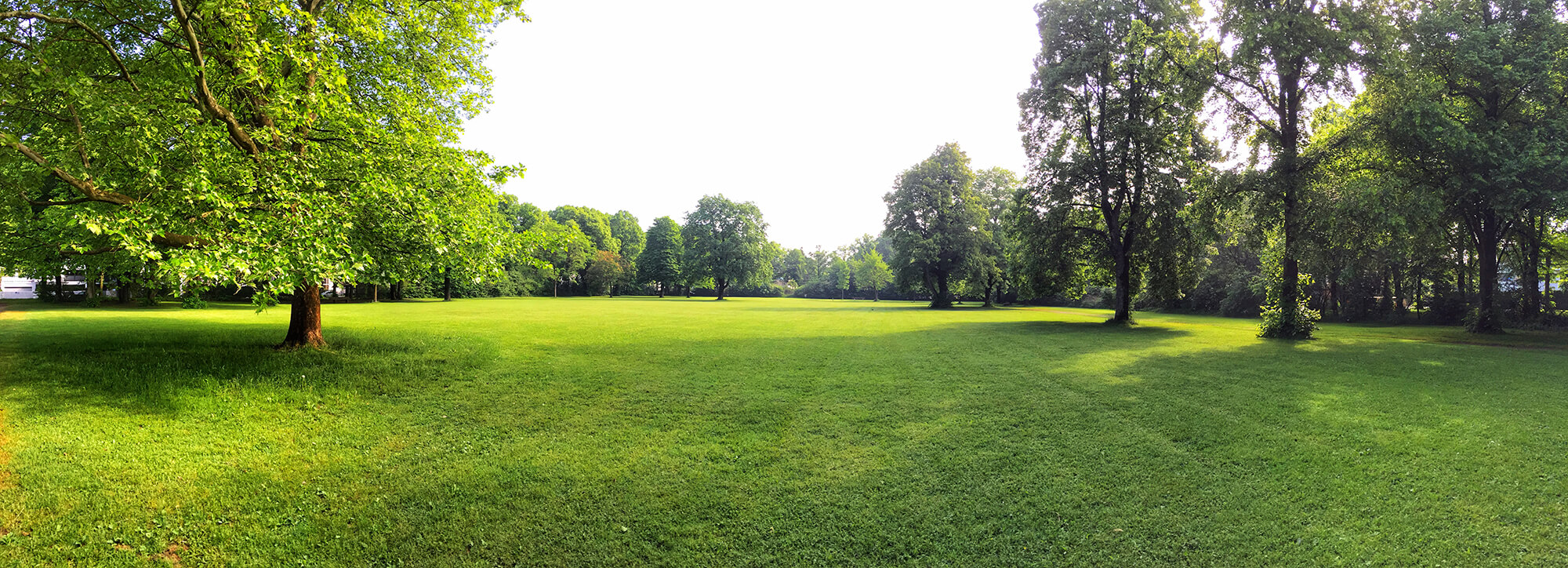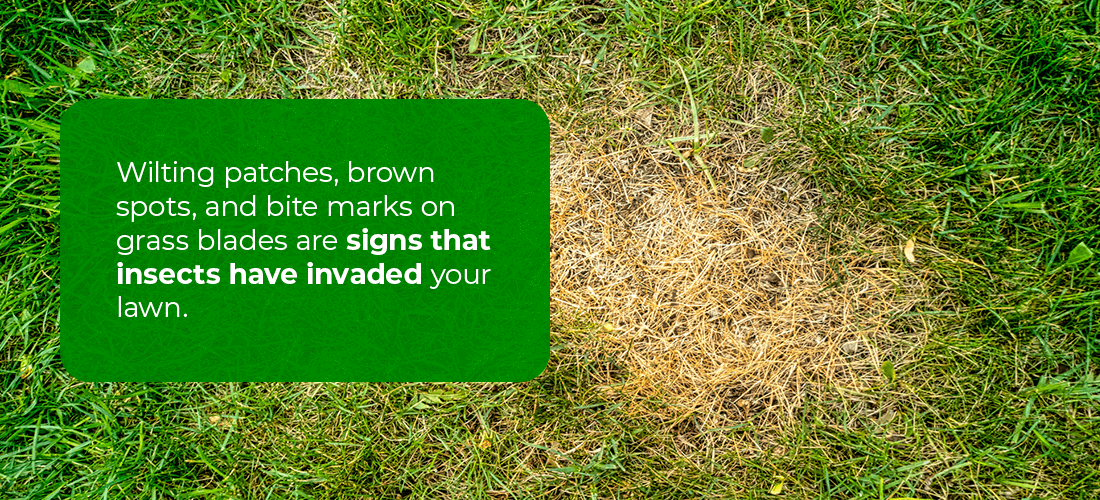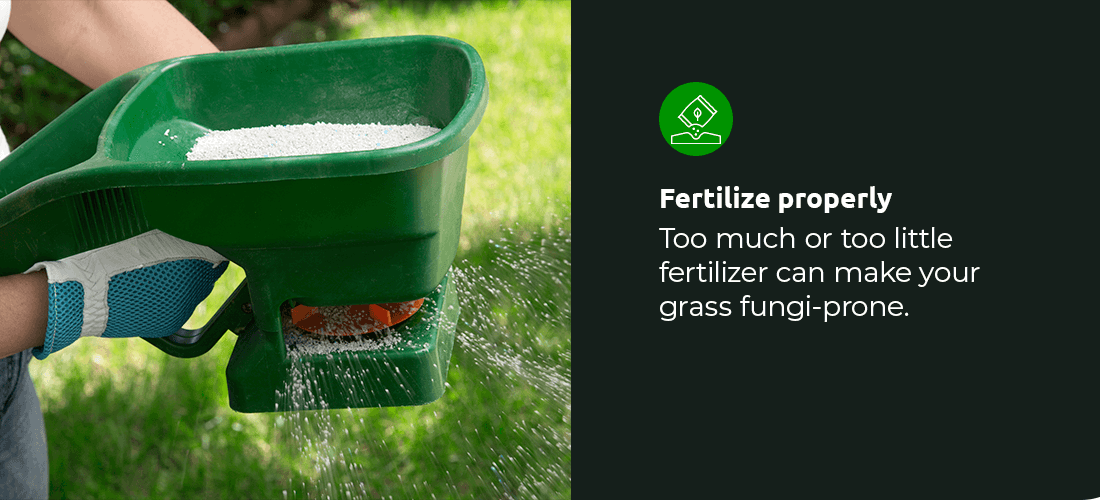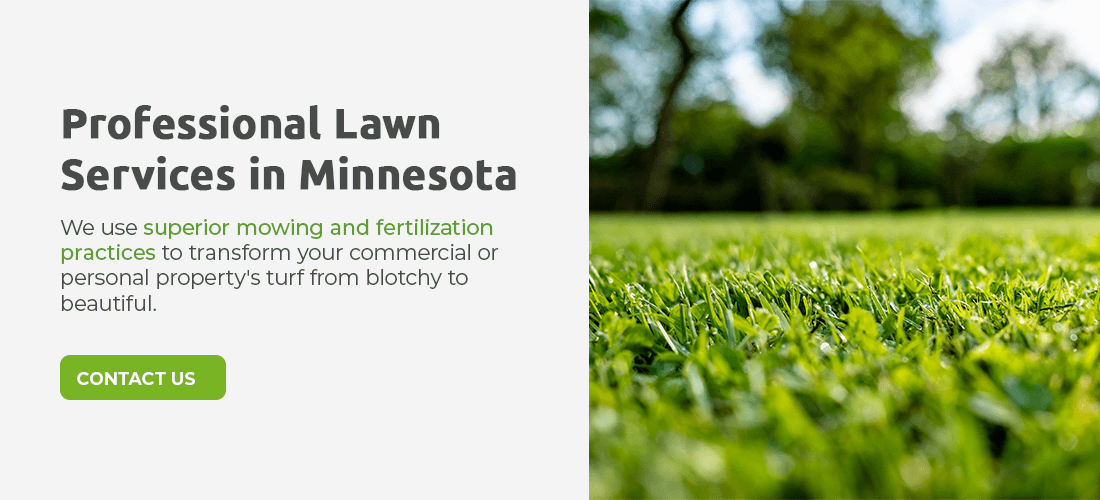Jump to:
Does your otherwise beautiful property have mysterious brown patches that won’t disappear, no matter how much you try to water or fertilize them? Are you tired of having lawn problems?
Curb appeal can make or break a first impression of your home or business, and a healthy, well-maintained lawn can impress visitors and increase your property value. We understand how frustrating a spotty lawn can be. Luckily for you, we’re here to help you banish those brown spots so your lawn can make the best impression on the block.
Discover what causes brown spots in the lawn, how to fix them and how to prevent their return with proven tips from our lawn maintenance experts.
Why Is My Lawn Turning Brown in Spots?
The first step to getting rid of brown spots in grass is to pinpoint the root of the problem. From weather conditions to animal influences, explore 12 common causes for your turf troubles.
- Drought: Minnesotans are no strangers to drought, one of the top reasons for brown grass. Since 2000, Minnesota has experienced intense drought periods, with the longest duration lasting 146 weeks. After two weeks without water, grass converts to a dormant state that can tolerate a lack of rain for up to six weeks and will revive with water. After lengthier dry periods, grass damage may become permanent with no chance of revival.
- Improper watering: Crunchy patches can develop due to under or overwatering. Shallow watering can cause weak roots. Avoid watering during the hottest times of the day and be sure to soak your lawn in the cooler mornings or early evenings a few hours before nightfall.
- Hydrophobic soil: Hydrophobic soil occurs when the ground becomes so dry it’s incapable of sufficiently absorbing water. Natural soil substances like fungal mycelium can cause a wax-like buildup that repels moisture. Without a moisture-rich dirt base, grass roots shrivel. With over 75% of Minnesota experiencing severe drought in recent summers, there’s a higher chance for properties to encounter this condition.
- Thatch: When your lawn isn’t adequately fed, mowed, or watered, a thick layer of decaying plant matter can accumulate between the grass blades and soil. If thatch buildup grows too thick, the grass roots won’t grow into the ground and instead will remain in the thatch layer, limiting nutrient intake and causing brown spots.
- Fungus: A common brown-patch culprit, the Rhizoctonia fungus affects cool-season grasses like tall fescue and ryegrass. Various fungus types cause irregular brown spots with dead grass rings. Fungi outbreaks are brought on by specific weather conditions — lack of sunlight, high humidity, excessive heat, rainy seasons, and poor air circulation.
- Incorrect mowing technique: Mowing the lawn too short or too frequently can hurt your yard, especially during hot summer months. Maintain healthy turf height between 3 and 4 inches. Forgo mowing wet grass and make sure your mower blades are sharp — dull blades can tear the grass instead of cutting it cleanly.
- Insects: Wilting patches, brown spots, and bite marks on grass blades are signs that insects have invaded your lawn. Bugs gravitate toward neglected, overly fertilized, and soggy yards. One of the most common lawn pests, beetle larvae grubs love to eat grass roots. Other common turf-damaging insects in Minnesota include Japanese beetles, sod webworms, and their adult form, white moths.
- Pet spots: Does it look like your lawn has polka dots? If you have several yellowish-brown lawn areas with dark green outer rings, it’s likely from a dog using the yard to relieve itself. Pet urine has a high amount of nitrogen that burns the grass, similar to applying too much synthetic fertilizer.
- Weed Dieback: You may find bare patches in the fall due to weed dieback. When annual weeds like bluegrass, foxtail, and crabgrass wither away at the end of the season, they can reveal areas that were weeds and not healthy turfgrass.
- Forgotten equipment: Does your staff leave equipment on your property’s lawn? Or do your children leave their playthings in the yard? It takes little time for grass to develop brown patches under forgotten things. Leaving furniture, wheelbarrows, machinery, kiddie pools, and toys in the same spot for days in a row disrupts the lawn’s access to air, water, and sunlight.
- Foot traffic: Repeated walking across the same area of the lawn can wear grass bare. If your family has worn a path at home or if customers continuously cut across the property in the same place to access your business, consider adding a permanent walkway with bricks, stepping stones, gravel, or mulch.
- Salt damage: During icy winter months, salt is used to treat sidewalks and streets. The spring thaw brings salt into grassy areas, especially lawn edges close to treated roads and driveways. Rock salt and other deicers dehydrate grass, resulting in lifeless lawn edges.
How to Fix Brown Lawn Patches in Lawn
Environmental factors outside your control, like seasonal changes, humidity changes and air temperatures, are leading causes of brown lawn patches. Fortunately, there are steps you can take to minimize the chance of spotty lawns.
7 Ways to Prevent and Correct Brown Patches In Your Yard And Maintain a Green Lawn
Feed the green, remove brown spots, and set up your lawn for consistent growth for years to come with these easy steps:
- Water appropriately: If high moisture levels contribute to the yard’s brown patches, remove standing dew in the mornings by dragging your water hose over the lawn. If hydration is lacking, soak your lawn about once a week to provide about an inch of water. Install a quality irrigation system to offset Minnesota’s irregular rainfall schedule and significantly improve your property.
- Fix hydrophobic soil: During extended droughts, the ground may stop absorbing water correctly. You can add granular or liquid wetting agents to break down the waxy nature of the earth, break the surface tension and make it easier for water to penetrate the ground.
- Fertilize properly: Anyone who’s had a pet goldfish has heard the number one rule — don’t overfeed it! In the same way, feeding your lawn is a delicate balance of using the right nutrients at the right frequency. Too much or too little fertilizer can make your grass fungi-prone. Talk to an experienced yard care provider to develop the best fertilization regimen to prevent weeds, fungus, and brown spots.
- Improve air circulation: Reduce the humidity factors contributing to fungus-based brown patches by dethatching and aerating your lawn annually. Aeration loosens compacted soil and promotes soil drainage to prevent fungi activation.
- Consider fungicide: Determining how to get rid of brown patch fungus on lawns often requires a multifaceted approach. Because the Rhizoctonia fungus thrives in hot, humid conditions, you should first reduce watering, improve drainage, and increase air movement. If fungus-driven brown patches persist annually, try fungicide treatments. Ideal for bentgrass and ryegrass turfs, fungicide works best when applied immediately after symptoms appear.
- Reseed with resistant turfgrass: To grow a lawn as lush and green football field, remember — the best offense is a great defense. Create a fungus-resistant yard by overseeding your property with resistant grass cultivars like Kentucky bluegrass and fine fescue species.
- Mow regularly: Like watering too frequently, over-mowing can have an adverse effect. Mow your lawn about once a week during the growing season to maintain a height between 3 and 4 inches, or hire a professional lawn service to implement best mowing practices to promote healthy grass blades, roots and color.
Professional Lawn Care Company in Minnesota
Are you looking for a professional lawn care company in the Twin Cities area to help you feed and maintain a gorgeous green lawn all season long? Look no further than Green & Black!
We use superior mowing and fertilization practices to transform your commercial or personal property’s turf from blotchy to beautiful. Our experienced Green & Black lawn specialists have the state-of-the-art equipment and know-how to provide a personalized, full-service lawn renovation plan to nourish your soil, kill existing weeds and maintain irrigation systems to treat your grass from root to tip.
If you’re ready to get rid of your lawn problems and have the best-looking lawn on the street, don’t hesitate to contact us online.




